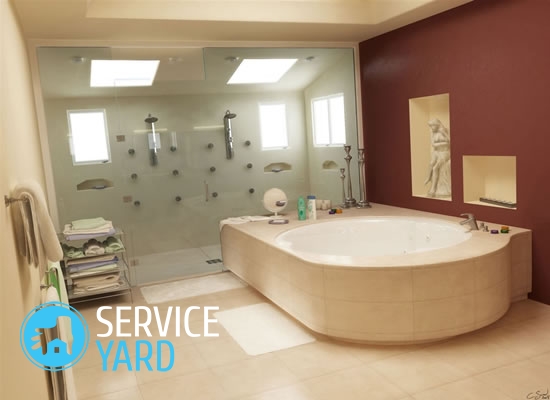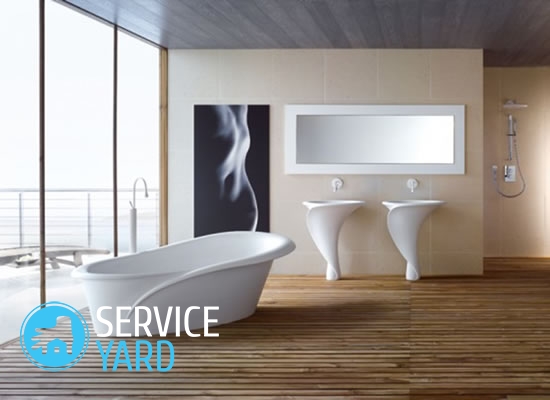Limescale agent

The main enemies of the cleanliness of the bathroom and toilet are limescale and rust. Therefore, many good housewives are concerned about the question, which remedy for limescale really effectively fights them. Knowing all methods of cleaning surfaces from plaque will facilitate the cleaning process of these rooms and help to find the desired cleanliness and brilliance of the bathroom. What exactly and how to apply, you will learn from this article.
to contents ↑Causes of plaque and rust in the bathroom
Tap water has never been of high quality. In its composition, it has many salts, microorganisms and mechanical particles. Steam with soap residues after bath procedures settles on all surfaces in the room. When drying, the salts that were in it, remain on the walls, floor, ceramic and enamel elements of the bathroom interior. Over time, such precipitation turns snow-white and radiant surfaces into dirty and rough coatings.
Rust can be the result of old plumbing, as well as poor quality materials. Under the influence of water, the fittings are oxidized. If the tap water has a large percentage of minerals, it begins to color the bath in the color of iron in those areas where it flows.
to contents ↑Important! Particularly favorable places for lime and rust to form are porcelain and acrylic surfaces.
How to get rid of plaque in the bathroom?
 There are quite a lot of remedies for limescale of various operating principles. Which one is more suitable in your case, choose based on the thickness of the deposits, the speed of their appearance, as well as from the family budget.
There are quite a lot of remedies for limescale of various operating principles. Which one is more suitable in your case, choose based on the thickness of the deposits, the speed of their appearance, as well as from the family budget.
Commercial surface cleaners
To date, many manufacturers of household chemicals offer their funds from limescale, differing in the form of release:
- Most of the products proposed for such purposes are made in the form of an acid-based gel. Due to the inclusion of such substances, they are very toxic to the human body. The use of such funds can provoke the development of allergies and other serious diseases. If in contact with skin, even a chemical burn is possible. But, given their high efficiency, it is not only possible to use them, but still need to. The main thing is to always do it carefully, in personal protective equipment.
- Powdered limescale and rust removers with continuous use can damage fine enamel. As a result, your beautiful bathroom will darken and lose its appeal. The chances of restoring her appearance are minimal. Therefore, it is recommended to use powders when plumbing materials have high resistance to abrasives.
- Steam cleaners - quite effective in combating this type of pollution. Steam quickly removes salt deposits on delicate surfaces without damaging them.
to contents ↑Important! Carefully read the instructions for such a household appliance. It is not necessary for a long time to keep the cultivated areas under hot steam.
Popular methods of removing lime scale
The main folk remedies in the fight against this problem are vinegar, soda, citric acid, hydrogen peroxide, salt and ammonia. All these substances are in the kitchen or in the first-aid kit of every housewife. They are inexpensive, but they are reliable assistants in maintaining the cleanliness of the bathroom.
Preliminary steps to achieve the best cleaning effect and ensure safety:
- Wash all surfaces from dirt, as you do every time, cleaning your bathroom. This will facilitate subsequent removal of lime layers.
- The smell of vinegar, ammonia and other folk detergents from limescale and rust can be, to put it mildly, unpleasant. To avoid damage to the mucous membranes and respiratory tract, open windows and doors before processing. Also, after applying any of the funds, you must quickly leave the room. It is best to perform any procedures with a respirator and gloves.
- For more convenient use of the prepared solution, place it in a spray bottle.
- After applying the product, which should last more than 30 minutes, periodically check that it does not dry. To do this, repeat the application of the solution every 15 minutes.
- After completing the cleaning procedure, rinse the surface of the bathtub with cold water. This will give pure enamel shine and snow-white radiance.
Important! You can use these tools separately. After all, even so they have a cleansing effect. After soaking the rag in vinegar, a solution of citric acid, hydrogen peroxide or ammonia, put it on a contaminated area. After 30-60 minutes, rinse with cold water. Fine table salt, as well as soda, acting as an abrasive, can clean surfaces by friction.
You should not take coarse grinding salt or clean delicate porcelain and acrylic baths in this way, since this cleaning can leave rough scratches on fine enamel.
Useful recipes
 To better understand what means and how to apply in order to remove limescale in the bathroom, check out the recipes below.
To better understand what means and how to apply in order to remove limescale in the bathroom, check out the recipes below.
Soda + Vinegar:
- Rub soiled surfaces with soda.
- Follow the same procedure using vinegar.
- Leave the mixture without rinsing for half an hour.
Important! In the process of a chemical reaction, dirt is removed from the surfaces, so the white foam familiar in this case will have a gray tint. Use cold water to rinse off the dirty composition.
Borax with lemon juice
The paste, which includes lemon juice and borax, is an effective cleaning agent against limescale. Apply it to the area to be cleaned and allow to dry. After that, simply rinse with cold water.
Oxalic acid
In the fight against rust, a solution of oxalic acid with water in a ratio of 1:10 is very effective. Apply it to a rusty stain, then rinse with clean water.
Ammonia + soda
To prepare such a paste, you need half a pack of soda and ammonia:
- Mix the ingredients until gruel.
- Rub a stain of rust with a stiff sponge.
- After 30 minutes, rinse with cold water.
Important! This method can be used to clean the entire bathroom.
Ammonia + hydrogen peroxide:
- Mix 2 parts ammonia with 1 part peroxide.
- Apply the resulting solution to the area with limescale or rust.
- Within half an hour do not rinse the treated areas.
Boiling water + vinegar
To clean faucets and other sanitary fittings, soak them in 1 liter of boiling water, to which 100 ml of vinegar is added.
Important! Plastic fittings should not be thrown into boiling water. Use just a hot solution to clean it.
If you are unable to remove the mixer from its place, then:
- Pour vinegar into a plastic bag.
- Tie it around the crane.
- After an hour, remove the bag and wipe the nozzle with a dry, clean cloth.
How to avoid the appearance of limescale and rust on the bathroom plumbing?
- Dry or wipe the bathtub and washbasin after showering or taking a bath with a dry cloth.
- Do not leave metallic objects on surfaces for long periods. If you nevertheless forgot to hide shaving foam in a metal can in time, then wipe immediately the place where it stood. Upon contact of a wet surface with metal, a rusty circle forms.
- The water filter will be a very successful, profitable and practical purchase. It softens hard water and relieves it of salts, which means that the formation of limescale will be minimized.
Stock footage
Using the information received, it is possible, without spending a lot of money, to effectively clean the surface of the toilet and bathroom from unwanted formations. Cleaning should be carried out as necessary, but do not delay it, since the more time passes, the thicker the layer of lime becomes and the more difficult it will be to remove it.
- How to choose a vacuum cleaner taking into account the characteristics of the house and coatings?
- What to look for when choosing a water delivery
- How to quickly create comfort at home - tips for housewives
- How to choose the perfect TV - useful tips
- What to look for when choosing blinds
- What should be running shoes?
- What useful things can you buy in a hardware store
- Iphone 11 pro max review
- Than iPhone is better than Android smartphones



